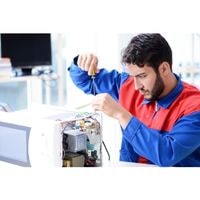LG oven won’t turn on. LG ovens are equipped with many innovative features and functions these days. Some of the more advanced ones can help you improve your cooking and make it more enjoyable.
Whether you are a busy mother or a professional chef, every oven owner will be happy to hear that the LG oven won’t turn on problems can usually be solved easily.
LG oven won’t turn on

Here is an overview of some of the common LG oven won’t turn on causes and how to fix them:
Problems with Incoming Power
If you’re having trouble turning on your traditional oven that runs via electricity, check the power source.
An electric oven will need 240 volts of alternating current. A gas oven will require 120 volts to operate.
You can use a multi-meter if your home is having any issues with an electrical outage or simply test the power supply at your wall outlet and see the amount of voltage it is providing once turned on.
Defective Bake Element
When the bake element is heating properly, it will glow red hot. If the bake element does not glow
red hot this indicates that there might be a problem with the bake element and often times if one of the components has burned out then they tend to become visibly damaged.
Inspecting the bake element for holes or blisters will help determine if a new heating element needs to be replaced as well as ensure that nothing was severely damaged during the thermal testing process.
Faulty Igniter
The Igniter is the most commonly defective part in gas ovens. The igniter has two main functions: to open the oven safety valve and to ignite the gas burner assembly.
If there is a problem with the igniter, it will not allow the safety valve to open properly which will prevent your oven from working.
To test if you’re igniter is faulty you should observe how long the igniter glows once your oven has been turned on.
If the igniter stays on for more than 90 seconds but does not ignite the burner, this indicates that it’s no longer able to perform its function correctly and should be replaced.
If there are no signs of ignition attempts at all, then you may need to test whether or not there is continuity running through your wiring by using a multimeter.
If there isn’t any continuity, then have a look at our tutorials about replacing an ignitor.
Broil Element has burned out
When the broil element is heating properly, it will glow red-hot. If the element does not glow red this indicates that the element is not heating up to temperature.
You can test for a blown broil element by taking a multimeter and testing for continuity. No continuity here is an indicator of a bad or burnt-out broil element. Replace as appropriate.
Below Thermal Fuse
The thermal fuse may trip if the oven overheats. If this happens, it will not turn on. However, this is not a common occurrence. To determine if the thermal fuse is at fault, use a multimeter to test the fuse for continuity.
If the thermal fuse does not have continuity, replace it. The thermal fuse cannot be reset if the fuse has blown you must replace it.
Replace Oven Control Board
The oven control board is what allows for user settings to be stored and run. The way in which this works is a pretty complicated process.
But the thing that owners need to understand is that if your stove’s control board isn’t working, it means that you can’t set the temperature of your oven or close the door of your stove.
In order for the heating components to work, there has to be voltage sent to them. A voltage divider circuit is involved in sending power to the lower heating elements so that they turn on when user settings are activated.
Since it’s so hard to test a control board, you will have to replace it if you suspect there is something wrong with your board or if it develops problems as its old age catches up with it.
The temperature control thermostat might be at fault
The oven thermostat monitors the temperature levels inside of your oven and cycles the heat on and off depending on the fluctuations detected in your food. If this oven thermostat were to fail, your oven would not turn on.
However, it is rare that an element would become defective like such. For example, if you notice flames coming out of your broil element or nothing happens when you hit bake, it’s very possible that these components are defective rather than the thermostat itself.
The temperature control thermostat cannot easily be tested because there are no user-friendly testing tools as of yet so we highly suggest replacing it altogether before recurring a faulty part.
Also, when in doubt about any particular repairs to make (whether you’re for yourself in your own home), call a professional.
An issue with Safety Valve
The gas oven safety valve works with the oven igniter to provide gas to the burner. If the safety valve fails, the oven won’t heat. However, this is rarely the cause.
Before replacing the safety valve, first test all of the more commonly defective components of your burners and coils, causing them to malfunction in this way.
Once you have tested your igniters and coils, you may proceed with testing out your safety valve by using a multimeter on its wires that are near or attached to it.
If at any point during these tests you come across a wire that does not show continuity, do not use the safety valve again; replace it altogether.
Related Guides
